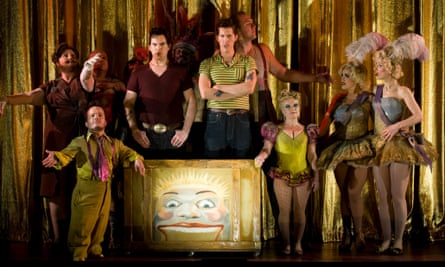A classic opera can withstand many interpretations throughout the years. Myself, I never know what a piece is really about until I’ve done it. Retrospectively if it works I can pretend I knew what I was doing. Any opera will mean different things each time a new creative team interpret it: we will not really know what our new production of Cosi fan Tutte will reveal until it is before an audience.
This production for English National Opera will be my fourth experience of mounting a large-scale opera. The works I’ve done so far have been two contemporary operas by Philip Glass: Satyagraha and The Perfect American, plus Enchanted Island - a newly created baroque pastiche - at New York’s Met. I’m a novice.
With a classic work such as Mozart’s Cosi fan Tutte there is the weight of previous productions that have gone before and supposedly succeeded or not. People are happy to tell you how difficult Cosi is. There’s one very particular challenge with this comedy of sex and disguise. The schemer Don Alfonso persuades two soldiers to test the fidelity of their lovers by disguising themselves and then wooing their best friend’s girlfriend. “It’s just not believable,” people have said to me. “How can the audience accept the idea that the disguises the boys put on are convincing?”
I don’t think it’s about creating a way of staging it that makes it feel realistic. After all don’t forget it’s an opera - they are singing everything they say! What a director does have to do though is create a theatrical frame that allows the audience to enjoy being conspirators in the whole conceit. One where they have permission to not worry about whether it is believable or not.
When working on any piece I’m in favour of making a bold intuitive choice and then pushing it to its limit. Otherwise you may as well set the whole thing in a drawing room. It was our designer Tom Pye’s idea to set the opera in a different world, and so our story takes place amid the fairground rides of a Coney Island seaside town. A place where the usual norms of behaviour are not quite the same and people want to believe in illusion. The two couples are lured to the fairground by impresario Don Alfonso and drawn into the magical world of the American Sideshow.

Opera doesn’t come alive until it starts to be enacted in the space. In the rehearsal room we have been playing back the recorded music so the performers are free to improvise in the space and explore scenes a myriad of ways. This keeps the performances alive as well as putting them in a vulnerable place - they can’t rely on repeating the scene in exactly the same way. They are always recreating in the moment. Many elements of our production have emerged in the rehearsal room as the performers have played with the scenes; there have been some theatrical solutions that could only have been thought of by an ensemble mind.
It’s been exhilarating, working with our brave singers and actors, feeling the opera reveal itself to me. I’ve been amazed at how beautiful it can be and at how much space there is for emotion to unfold within the music. The themes that we have managed to draw out of it seem to be about “normality” and fluidity of sex and identity. This opera sets the men off on a journey of deceit to prove the faithfulness of their partners, and on the way they and the women find out as much about themselves as they do about their lovers.
As we have with our other Improbable opera productions we’ve put together a company of non-singing “skills performers” who facilitate the magic of our changing settings and scenarios. Led by Don Alfonso they are a sideshow crew of beautiful “carneys” and “freaks”. They’re the unearthly fairies who are making the magic happen in our underworld midsummer dream.

As I watch our technical and stage rehearsals and I see how ridiculously ambitious we are being I find myself wondering why don’t I give myself an easier ride. (That old-fashioned drawing room set seems strangely appealing). Then again we would never find something new in this art form if we didn’t invite some questions. The wonderful thing about opera is you can never know what it might become. There are so many elements that to try and control them would be hubristic. All you can do is aim to create the conditions where it might all join together and that depends not least upon the audience and the atmosphere they will bring.
Cosi fan Tutte is at the Coliseum, London, from 16 May to 2 July. Details: eno.org/cosi







Comments (…)
Sign in or create your Guardian account to join the discussion